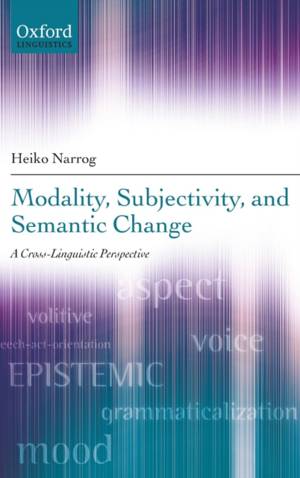
- Retrait gratuit dans votre magasin Club
- 7.000.000 titres dans notre catalogue
- Payer en toute sécurité
- Toujours un magasin près de chez vous
- Retrait gratuit dans votre magasin Club
- 7.000.000 titres dans notre catalogue
- Payer en toute sécurité
- Toujours un magasin près de chez vous
Modality, Subjectivity, and Semantic Change: A Cross-Linguistic Perspective
A Cross-Linguistic Perspective
Heiko Narrog
265,95 €
+ 531 points
Description
This book is a cross-linguistic exploration of semantic and functional change in modal markers. Its approach is broadly functional typological but makes frequent reference to work in formal semantics by scholars such as Angelika Kratzer and Paul Portner. The author starts by considering what modality is and how it relates to and differs from subjectivity. He argues that modality cannot be defined in terms of subjectivity: both concepts are independent of each other, the first exhibiting different degrees of subjectivity, and the second being operative in a much wider range of grammatical and lexical categories. Subjectivity, he suggests, should not be defined solely in terms of performativity, evidentiality, or construal, but rather from the interplay of multiple semantic and pragmatic factors. He then presents a two-dimensional model for the descriptive representation of modality, based on the notion that among the many aspects of modal meaning, volitivity and speech-act-orientation versus event-orientation are two of its most salient parameters. He shows that it is especially the dimension of speech-act orientation versus event-orientation, parallel to category climbing in syntax, that is operative in diachronic change. Numerous examples of diachronic change within modality and between modality and other categories are then examined with respect to their directionality. With a focus on Japanese and to a lesser extent Chinese the book is a countercheck to hypotheses built on the Indo-European languages. It also contains numerous illustrations from other languages.
Spécifications
Parties prenantes
- Auteur(s) :
- Editeur:
Contenu
- Nombre de pages :
- 348
- Langue:
- Anglais
- Collection :
Caractéristiques
- EAN:
- 9780199694372
- Date de parution :
- 29-09-12
- Format:
- Livre relié
- Format numérique:
- Genaaid
- Dimensions :
- 157 mm x 234 mm
- Poids :
- 680 g







